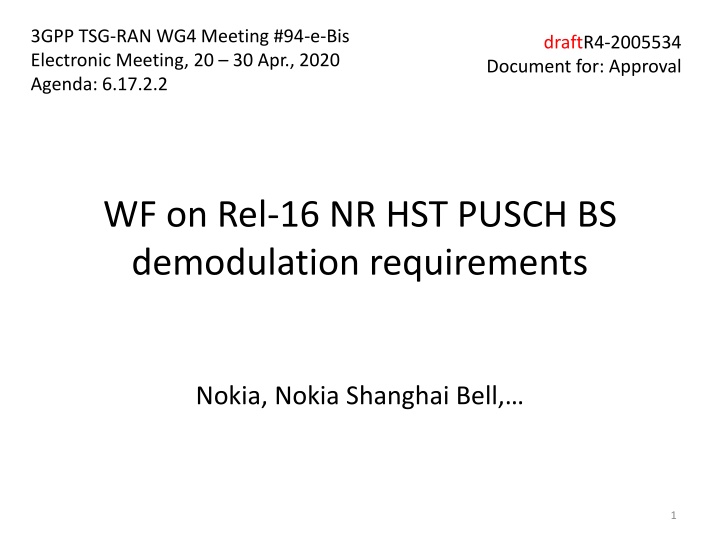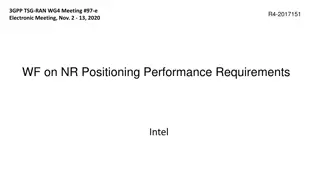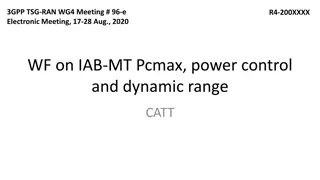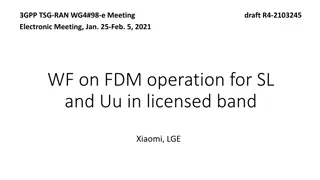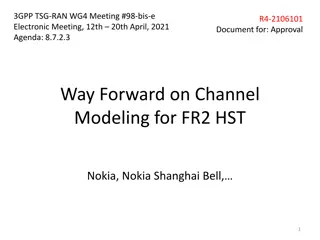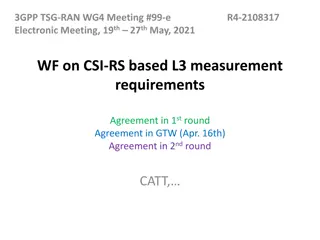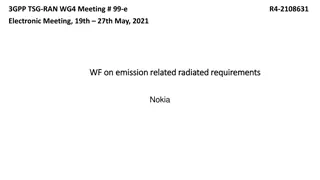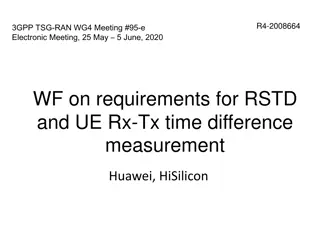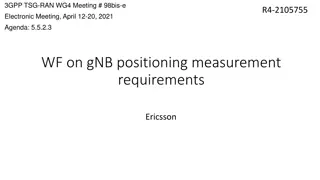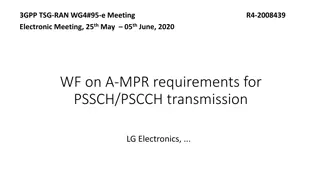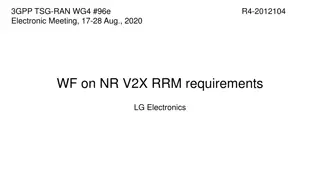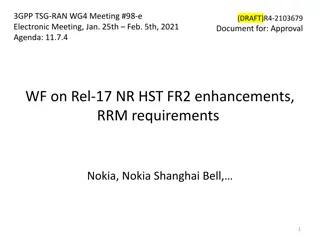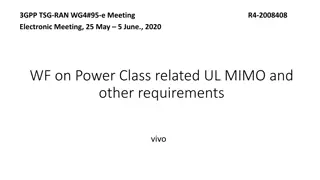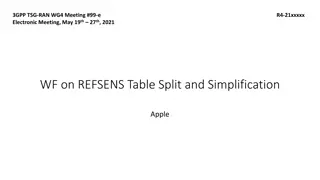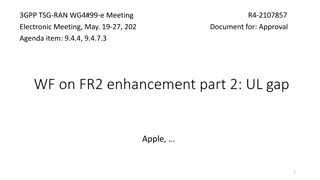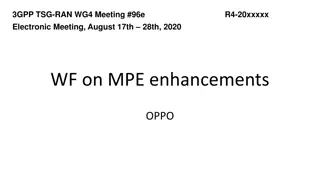3GPP TSG-RAN WG4 Meeting Agenda: Approval WF on Rel-16 NR HST PUSCH BS Demodulation Requirements
This document outlines the agenda for the 3GPP TSG-RAN WG4 meeting, focusing on the approval of the Work Item (WF) related to Release 16 NR (New Radio) High-Speed Train (HST) Physical Uplink Shared Channel (PUSCH) Base Station (BS) demodulation requirements. It includes background information, agreed workflows from previous meetings, and specifications for organizing high-speed train requirement sections. The document also discusses formalizing notes in the specification, performance requirements, scenario naming, and more.
Download Presentation

Please find below an Image/Link to download the presentation.
The content on the website is provided AS IS for your information and personal use only. It may not be sold, licensed, or shared on other websites without obtaining consent from the author.If you encounter any issues during the download, it is possible that the publisher has removed the file from their server.
You are allowed to download the files provided on this website for personal or commercial use, subject to the condition that they are used lawfully. All files are the property of their respective owners.
The content on the website is provided AS IS for your information and personal use only. It may not be sold, licensed, or shared on other websites without obtaining consent from the author.
E N D
Presentation Transcript
3GPP TSG-RAN WG4 Meeting #94-e-Bis Electronic Meeting, 20 30 Apr., 2020 Agenda: 6.17.2.2 draftR4-2005534 Document for: Approval WF on Rel-16 NR HST PUSCH BS demodulation requirements Nokia, Nokia Shanghai Bell, 1
Background Agreed WFs for PUSCH in previous meetings R4-1910128 Way forward on NR HST BS demodulation requirements, RAN4#92. R4-1912809 Way forward on NR HST PUSCH demodulation requirements, RAN4#92Bis. R4-1915886 Way forward on NR HST PUSCH demodulation requirements, RAN4#93. Agreed WFs for PRACH in previous meetings R4-1910128 WF on NR BS HST demodulation requirements , RAN4#92. R4-1912729 WF on NR HST BS PRACH demodulation requirements, RAN4#92b. R4-1915871 Way forward on NR HST PRACH demodulation requirement, RAN4#93. Agreed WFs for BS demod in previous meetings R4-2002405, WF on Rel-16 NR HST BS demodulation requirements, RAN4#94-e. (The content in WF R4-2002405 except slide 16 is agreed; see meeting minutes.) Corresponding Email summary in RAN4#94-e-Bis R4-2005594 Email discussion summary for [94e Bis][223] NR_HST_Demod_BS. 2
Specification text Agreements from 1st round Organisation of high-speed train requirement sections for PUSCH 500kph in specifications Re-use the HST PUSCH section currently used for 350kph to capture 500kph requirements Formalization of l0=2 or l0=3 notes in TS 38.104 specification Minimum performance requirement specification (TS 38.104) does not explicitly capture the l0=2 or l0=3 option in its test parameter. The options are captured in the FRC descriptions. Renaming of HST scenario 1 No change to HST scenario naming. 3
Specification Text Organisation of high-speed train requirement sections for PUSCH 500kph in specifications Option 1: One new table for 500kph requirements Option 2: Merge 500kph requirements into table with 350kph requirements. Proposed WF: Discuss by email. 4
Specification Text Organisation of high-speed train requirement sections for PUSCH DFT-s-OFDM in specifications Option 1: In HST PUSCH section currently used for 350kph (e.g., 38.104 section 8.2.4) New test parameter table and minimum requirements tables(s) for transform precoding = on . Option 2: TBD after DFT-s-OFDM agreement. Proposed WF TBD after DFT-s-OFDM introduction agreement. 5
Specification Text Organisation of high-speed train requirement sections for PUSCH fading channel under high Doppler in specifications Option 1: Introduce in non-HST PUSCH section. Option 2: Introduce in HST PUSCH section. Option 3: TBD after PUSCH fading channel under high Doppler agreement. Proposed WF TBD after PUSCH fading channel under high Doppler agreement. 6
Applicability rules and declarations Agreements from 1st round Relationship between TDD and FDD requirements Same requirements applicable for FDD and TDD; only one case simulated for result delivery. Parameter tables show SRS mapping for FDD and TDD separately. 7
Applicability rules and declarations High speed implicit test passing Option 1: No implicit test passing. A BS claiming to support 350kph must test all the requirements of 350kph, even if it has passed the same configuration in 500kph. Option 2: Allow implicit test passing. A BS that declares to support 500kph, and passes the tests for 500kph, can also consider the tests for 350kph as passed. Option 3: A BS that declares to support 500kph, and passes the tests for 500kph, can also consider the tests for 350kph as passed if the configurations are same and algorithm optimizations are implemented for both 500kph and 350kph. Proposed WF Discuss by email. 8
Applicability rules and declarations High speed support declaration for HST PUSCH Option 1: Declare category of supported maximum speed. This can be either 350 or 500kph (or no HST support). Which tests need to be passed, if 500kph is declared, is discussed separately under High speed implicit test passing Option 2: Declare category of supported design target speed(s). This can be 350 or 500 or 350&500kph (or no HST support). Only the corresponding requirements are tested (only 350&500kph tests both). Proposed WF Discuss by email. 9
Applicability rules and declarations If Dft-s-OFDM is introduced: Applicability rule Option 1: Similar applicability rule for waveforms as existing PUSCH performance requirements will be used for HST Option 2: TBD after DFT-s-OFDM decision. Proposed WF TBD after DFT-s-OFDM introduction agreement. 10
Configurations to be tested Agreements from 1st round If 1T1R requirement is introduced: 1T1R requirement configuration Re-use the 1T2R requirement configuration. Slot allocation Only capture to use TDD pattern according to the previous WF agreement [R4-1915886]: Reuse the existing TDD configurations. 15 kHz SCS: 3D1S1U, S=10D:2G:2U 30 kHz SCS: 7D1S2U, S=6D:4G:4U 11
Configurations to be tested Introduce 1T1R requirements for the tunnel scenario Option 1: Introduce 1T1R requirements for the tunnel scenario, for conducted only. Option 2: Do not introduce 1T1R requirements for the tunnel scenario Proposed WF Compromise to option 1. 12
Configurations to be tested If 1T1R requirement is introduced: MCS configuration Option 1: If 1T1R requirement is introduced, only have MCS 2 requirements. Option 2: If 1T1R requirement is introduced, have MCS 2 and MCS16 requirements. Proposed WF: TBD after 1T1R introduction agreed. If 1T1R requirement is introduced with OTA testing: 1T1R requirement configuration TBD. Proposed WF: Do not introduce OTA testing. 13
Configurations to be tested Dft-s-OFDM waveform Option 1: Introduce PUSCH HST requirements for DFT-s-OFDM. Option 2: Do not introduce PUSCH HST requirements for DFT-s-OFDM Proposed WF: Discuss by email. If Dft-s-OFDM is introduced: Configuration Option 1 Configuration as follows. 500kph only, MCS2, RB allocation: 24 RB for 5MHz CBW/15KHz SCS, TDRA: type A, DMRS position: 1+1+1, L0: 3. Option 2: Minimum channel bandwidth (i.e., 5MHz for 15 kHz SCS, 10MHz for 30 kHz SCS) Option 3: Define HST requirements with DFT-s-OFDM for both 350 km/h and 500 km/h. Option 4: TBD after Dft-s-OFDM decision. Proposed WF: TBD after DFT-s-OFDM introduction agreement. 14
Configurations to be tested Multi-path fading channel under high Doppler value Option 1: Do not specify requirements for multi-path fading channel models with high Doppler values. Option 2: Specify PUSCH requirements for multi-path fading channel with maximum doppler shift of 1200Hz and 2400Hz for 15kHz SCS and 30kHz SCS, respectively. Option 3: Specify PUSCH requirements for multi-path fading channel with maximum doppler shift of 600Hz and 1200Hz for 15kHz SCS and 30kHz SCS, respectively. Proposed WF: FFS until next meeting. Or if time permits later this meeting. Is multi-path fading channel under high Doppler value a common scenario? Option 1: Multi-path fading channel is very rare in HST scenarios (open area or tunnel). Option 2: Fading channel is also typical condition in the real propagation under high speed. Proposed WF: FFS until next meeting. Or if time permits later this meeting. 15
Configurations to be tested Additional CBW and SCS combinations Option 1: Add requirements for 5MHz CBW/15kHz SCS, 10Mhz CBW/30kHz SCS for CP-OFDM. Option 2: No additional CBW requirement for HST PUSCH requirement with CP-OFDM. Proposed WF: Discuss by email. 16
